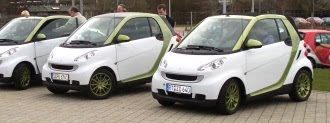 We’re at Mercedes-Benz World in Surrey today, but not to admire all the cars sporting a three-pointed star. Up among the rafters, at attic level in the steel and glass showroom, you can find the silver arrows’ ugly sibling: Smart.
We’re at Mercedes-Benz World in Surrey today, but not to admire all the cars sporting a three-pointed star. Up among the rafters, at attic level in the steel and glass showroom, you can find the silver arrows’ ugly sibling: Smart.
Way down at ground level, round the back, a Smart ForTwo coupé awaits us, liveried in white and metallic green. We are about to test drive a second-generation electric Smart ED, complete with its Tesla-derived lithium-ion battery, and we’re keen to see how it compares to the first generation Smart ED we drove in September.
Our car is a German-registered, left-hand-drive convertible – similar but not identical to the cars that will take part in the UK public trial later this year. They will all be right-hookers with fixed roofs.
Inside, the Smart is virtually unaltered compared to its fossil-fuelled brothers and sisters. Two green-rimmed pods on the dashboard keep the driver up to speed with the state of battery, the left gauge showing battery reserves and the right giving a swingometer indication of how discharge or regeneration of energy is going.
The stubby gearlever, down between the seats, offers an unfussy linear arrangement of park, reverse, neutral and drive options . There’s only one forward ratio. Ahead of the lever we note a round, red panic button that can shut off the high-voltage electrical system, but apparently this will not feature on the trial cars.
Switched on, in gear, handbrake off and feet off the pedals, and the Smart is silent and motionless. There’s no trace of the thrum or vibration that kept us company in the first generation car. The slight throttle hesitation we noticed last time has also been cured. Response is now instant and fine control is faithful. Stroke the accelerator gently and the car inches forward smoothly and gracefully, push on firmly and the car responds promptly with a decent amount of urge. We play at drag-racing on the closed Mercedes circuit, and while no sports cars were left alarmed by our pace, the Smart ED is more than capable of city sprints between traffic lights. There’s a noticeable notch at the end of the accelerator’s travel, and pushing the pedal beyond it opens up a go-faster mode. Normal output from the electric motor is only 27bhp, but burying the pedal yields 40bhp for up to two minutes. You can certainly feel the difference.
We play at drag-racing on the closed Mercedes circuit, and while no sports cars were left alarmed by our pace, the Smart ED is more than capable of city sprints between traffic lights. There’s a noticeable notch at the end of the accelerator’s travel, and pushing the pedal beyond it opens up a go-faster mode. Normal output from the electric motor is only 27bhp, but burying the pedal yields 40bhp for up to two minutes. You can certainly feel the difference.
The battery pack has clearly given the Smart ED a usefully low centre of gravity, while the extra weight – 140kg more than a diesel Smart – keeps all four wheels firmly planted. Our emergency stop from a terminal-velocity 60mph offers little drama, the ABS-equipped brakes proving more than equal to the task despite the extra weight. We’ve read elsewhere that the transition between hydraulic and regenerative braking can be less than smooth on some electric Smarts, but we try and fail to replicate the issue. It seems that the braking has received some successful polishing from Smart’s engineers.
On a dry surface, we also find no trace of understeer and remarkably little body roll. We try a full-throttle slalom from rest and run out of arm-twirling skill before the Smart runs out of body control or grip. Unfortunately, our minder won’t let us take the car onto the water-soaked skid-pan to assess the car’s wet-weather manners.
All in all, the second-generation Smart ED feels like a significantly better car than its predecessor. No doubt the 100 recipients of UK trial vehicles will be happy with their rides – the first will be handed over in the summer.
As good as the car is, though, we still feel that the trial is a tall order financially. Handing over £4,000-plus for just the first year in a Smart ED seems like too much for too little, to us. No doubt Smart will have no trouble finding 100 willing volunteers for its market research trial – but we fear the results will be firmly skewed towards the driving habits of the comfortably well-heeled.
Road test: driving the second-generation electric Smart
14 March 2010
Read more about: electric cars small cars Smart



